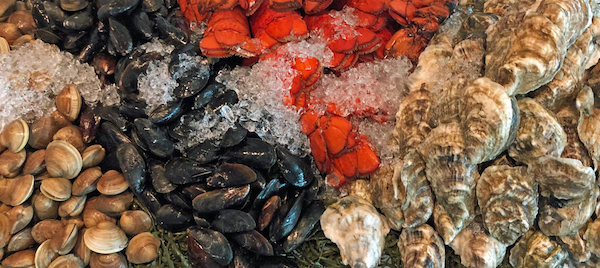Seafood Safety Guide: Make the Most of Frozen Seafood

Whether you’re a seasoned pro looking to expand your menu, or a new chef entering the world of seafood, there’s a lot to learn. Knowing your way around fish and seafood keeps consumers safe and enables you to make the most of these beautiful ingredients.
Here are some key pointers to help you serve safe and delicious seafood dishes.
Selecting and Serving Fresh and Frozen Seafood Safely
Studies show that in recent years, about a quarter of Americans have consistently wanted to eat less meat, and for the first time, their preference to replace red meat is fish and seafood. This is a positive shift, as many home cooks feel apprehensive about cooking fish. Chef Mark Usewicz said in a New York Times piece, “It is amazing how afraid people are of fish. Afraid of cooking it, afraid of buying it, afraid of keeping it.”
Knowing your seafood facts can empower professional and amateur cooks to be more adventurous when cooking and serving seafood. Once you’ve mastered handling and cooking seafood safely, many more options are available to you!
What’s the Right Way to Handle and Store Seafood?
The best storage method depends on whether you’re dealing with raw or cooked seafood. Firstly, you want to store and prepare raw seafood separately to avoid contaminating cooked seafood. Thaw seafood in the fridge overnight to ensure it fully defrosts before use.
Consume fresh or thawed seafood within 48 hours of being in the refrigerator so you’re eating it at its best.
What Do Consumers Need to Do to Keep Seafood Safe?
When buying fresh fish, note the date of purchase so you’re conscious of its expiry date. Frozen fish and seafood have a longer shelf life, and will store for several months in the freezer.
Identifying uncooked spoiled seafood can give you confidence in the kitchen. Premium quality fish and seafood will be firm to the touch. The Food Safety website recommends looking out for these signs:
- Fish should smell fresh and mild, not fishy, sour, or ammonia-like.
- A fish’s eyes should be clear and shiny.
- Whole fish should have firm flesh and red gills with no odor. Fresh fillets should have firm flesh, red bloodlines, or red flesh if fresh tuna. The flesh should spring back when pressed.
- Fish fillets should display no discoloration, darkening, or drying around the edges.
- Shrimp, scallops, and lobster flesh should be clear with a pearl-like color and little or no odor.
Regarding shellfish, advice is to discard broken or cracked shells. Throw away clams, oysters, and mussels if their shells are cracked or broken because they may be compromised. You can also do a “tap test.” Live clams, oysters, and mussels will close when the shell is tapped.
Many chefs would consider it easier and safer to serve hot seafood because you can temperature-check the dish to ensure it’s safe to eat. That doesn’t mean you should avoid serving cold seafood, though! Many of America’s favorite seafood dishes, like shrimp cocktail, are served cold.
Eating Raw Seafood — What You Need To Know
Sushi is now one of the most widely-eaten foods in America, and as more consumers are keen to eat raw fish, chefs, and consumers must be familiar with handling raw seafood.
There is a difference, of course, between intentionally raw or undercooked fish. The freshness of the fish is crucial — even more so when served raw. Frozen fish and seafood are ideal for raw dishes, as they are frozen at source. The US Food and Drugs Administration (FDA) stipulates that all fish and seafood served raw, including as sushi, must first be frozen to ensure it is safe to eat.
You can read more about PanaPesca sustainability on our website and browse our premium seafood for food services online.

